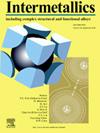Design and development of large-diameter Mg-Zn-Ca bulk metallic glass for biomedical applications: A mechanical and corrosion perspective
IF 4.3
2区 材料科学
Q2 CHEMISTRY, PHYSICAL
引用次数: 0
Abstract
Being amorphous, bulk metallic glasses (BMGs) exhibit superior properties compared to their crystalline alloy counterparts. Amorphous materials are preferred for their excellent mechanical and degradation behavior. Among the various elemental combinations, MgZnCa has shown the most promising results, as evidenced by the literature. However, the maximum achievable size of the metallic glasses remains a bottleneck. The current work aims to address this challenge and achieve it splendidly with a systematic methodology by developing larger diameter MgZnCa BMGs through vacuum induction casting using a specially designed copper mold. The optimal composition was formalized for glass formation of the Mg65Zn31Ca4 system using the CALPHAD technique. As a result, a 6.5 mm diameter glassy alloy was successfully obtained. The XRD and TEM analysis experiments demonstrated a perfect amorphous structure of the developed sample. The anti-corrosion properties of the as-cast glass increased, followed by enhancement in the yield strength and hardness in contrast to the properties of the human bone. Furthermore, the surface wettability analysis showed an adequate surface obtained to promote fibroblast adhesion. In conclusion, the current work represents a notable progress in the fabrication of larger-diameter MgZnCa BMG for biomedical applications, considering that the biggest diameter ever reported in the MgZnCa system was more than a decade ago.
用于生物医学应用的大直径 Mg-Zn-Ca 块状金属玻璃的设计与开发:机械和腐蚀视角
与结晶合金相比,非晶体金属玻璃(BMG)具有更优异的性能。无定形材料因其出色的机械性能和降解性能而备受青睐。文献证明,在各种元素组合中,MgZnCa 的效果最好。然而,金属玻璃的最大尺寸仍然是一个瓶颈。目前的工作旨在应对这一挑战,并通过系统化的方法,利用专门设计的铜模,通过真空感应铸造技术开发出更大直径的 MgZnCa BMG,从而出色地实现了这一目标。利用 CALPHAD 技术正式确定了 Mg65Zn31Ca4 系统玻璃形成的最佳成分。结果,成功获得了直径为 6.5 毫米的玻璃合金。XRD 和 TEM 分析实验表明,研制出的样品具有完美的无定形结构。铸件玻璃的抗腐蚀性能增强,屈服强度和硬度也随之提高,这与人体骨骼的特性形成了鲜明对比。此外,表面润湿性分析表明,所获得的表面足以促进成纤维细胞的粘附。总之,考虑到 MgZnCa 系统的最大直径是在十多年前报道的,目前的工作代表了在制造用于生物医学应用的更大直径 MgZnCa BMG 方面取得的显著进展。
本文章由计算机程序翻译,如有差异,请以英文原文为准。
求助全文
约1分钟内获得全文
求助全文
来源期刊

Intermetallics
工程技术-材料科学:综合
CiteScore
7.80
自引率
9.10%
发文量
291
审稿时长
37 days
期刊介绍:
This journal is a platform for publishing innovative research and overviews for advancing our understanding of the structure, property, and functionality of complex metallic alloys, including intermetallics, metallic glasses, and high entropy alloys.
The journal reports the science and engineering of metallic materials in the following aspects:
Theories and experiments which address the relationship between property and structure in all length scales.
Physical modeling and numerical simulations which provide a comprehensive understanding of experimental observations.
Stimulated methodologies to characterize the structure and chemistry of materials that correlate the properties.
Technological applications resulting from the understanding of property-structure relationship in materials.
Novel and cutting-edge results warranting rapid communication.
The journal also publishes special issues on selected topics and overviews by invitation only.
 求助内容:
求助内容: 应助结果提醒方式:
应助结果提醒方式:


